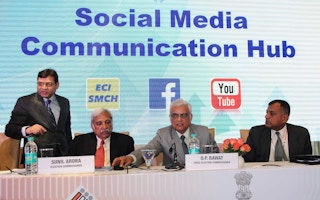A new wave of local, or ‘swadeshi’, social media start-ups aims to disrupt India’s reliance on foreign platform-driven communications – but political backing and scant content moderation are red flags.
The term swadeshi originally meant economic, political and cultural independence from Britain, but today the word is imbued with nationalist, ‘made in India’ overtones. Swadeshi apps can be loosely defined as apps that are explicitly supportive of the present government’s nationalist agenda and willingly accept governmental control or those that are keen to establish an alternative to the dominance of Big Tech. Given the language diversity in India and the reality of Hindi-English dominance, there is ample scope for language and dialect-specific apps.
Large tech platforms can’t ignore India: their Indian user bases are significantly larger than those in the United States. The Indian government, which has a legislative requirement to police content, has attempted some regulatory measures. Its Equalisation Levy (2016) created a tax regime specifically for the online economy, while the Indian Personal Data Protection Bill (2019), Data Accessibility and Use Policy have focused on users’ rights.
The need to be actively involved offers the government opportunities to shape platform rules and take down, control and censor content. The government is notorious for its habitual attempts to censor social media in ‘disturbed’ areas, including Kashmir and North-East India, and during the year-long farmer demonstrations in Delhi, Uttar Pradesh and Haryana.
These efforts at censorship have been hampered by the government’s inability to make social media companies keep copies of their consumer transactions in India. But there is another approach to curbing the power of global social media companies: to encourage and invest in indigenous social media companies.
Following China’s lead, India’s Hindu nationalist government is a keen advocate for a wholly indigenous media infrastructure. China’s indigenous apps, such as WeChat and Weibo, allow the state to exercise more control over the social ecology of its citizens than a multinational platform would grant.
Indian yoga entrepreneur and businessman Baba Ramdev launched a swadeshi WhatsApp lookalike, Kimbho, in 2018. It has been plagued by security concerns and has recently reinvented itself as the chat app Bolo Messenger, which has faced some of the same issues.
India’s ban on the Chinese short-video app TikTok in 2020, following major border clashes between China and India, led to a flurry of swadeshi apps, including Sharechat, Koo, Josh, Mitron, VerSe, Roposo and Chingari.
But Instagram, Facebook and Twitter continue to command a larger market share. The fact that Koo is backed by investors from China has dented its ambitions, while Tooter, the Twitter rival launched in 2021, is allegedly a copy of the right-wing US site Gab.
Twitter helps politicians grow their following and communicate their agenda widely, but it continues to be swamped by disinformation and bots. WhatsApp hosts everyday conversations but is also home to groups that recruit, mobilise and organise coordinated extremist actions.
While there is implicit government support for swadeshi sites, the ruling Bharatiya Janata Party (BJP) has been less forthright in explicitly backing any, since none are in a position to challenge the heft of global tech companies like Facebook and Twitter.
Tooter has claimed that Prime Minister Narendra Modi’s Tooter account has 20,400 followers and 778 posts, but BJP officials have pointed out these are just copies of posts he has made on Twitter. Right-wing influencers like Modi are canny enough to recognise the political mileage related to the sentiment of swadeshi start-up enthusiasts, but they favour pragmatism over significant presence on these sites.
Like its counterpart in the US, India’s right wing has felt that Twitter and other platforms have been anti-conservative. They have especially decried attempts at content moderation that they feel have unfairly impacted on their belief in and right to free speech, inclusive of hate speech, and the fact that foreign-owned Big Tech platforms have not complied with takedowns directed by the Indian government in full. It is not surprising that lack of content moderation is a pronounced public feature on sites like Koo and Tooter.
While these new, domestic start-ups have political support and are trying to exploit the potential for regional content, their global competitors have also begun investing in localisation and language support.
The government also has to balance internal dissensions and divisions with respect to social media platforms. The economic wing of the Rashtriya Swayamsevak Sangh political party, the Swadeshi Jagran Manch, has taken a stridently regulatory position. As a government with global ambitions and responsibilities, Modi’s administration must also balance its trading relationship with the US, an economic ally and home to many big social media companies.
While competition in the marketplace for social media is an absolute necessity, indigenous social media platforms may do more harm than good in India. Already, the government does not intervene in Hindu right-wing social media activism. Indigenous social media platforms risk being further weaponised against minorities and polarising communities.
What does this mean for countervailing power online? Perhaps India does not need many social media platforms to cater to the diverse interests of the Indian public. But if the current state of legacy media in India is anything to go by, this space too will come under the state’s control. The issue will not ultimately be ‘English versus vernacular language social media’ or ‘transnational versus indigenous social media’ but whether social media platforms will remain an independent space for all views.
Pradip Ninan Thomas is an Associate Professor in the School of Communication and Arts at the University of Queensland. The author declared no conflicts of interest in relation to this article.
Originally published under Creative Commons by 360info™.

















